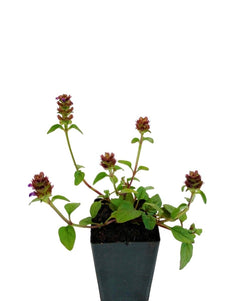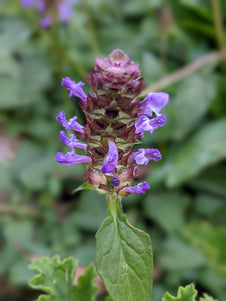





Self Heal
Self Heal

- In stock, ready to ship
- Inventory on the way

Usually available: All year
Life cycle: Perennial
Height: 10 - 30cm
Position: Sun / part shade
Soil preference: Well drained
This is how we pack and send your Herb Plants to all states except TAS & WA
You will receive
- 1 Self Heal Herb Plant in a 50 X 75mm tube - General growing instructions
All of our Herb Plants are grown organically with certified organic potting mixes and fertilizers
Botanical Name: Prunella vulgaris
Self Heal, with the scientific name Prunella vulgaris, is a low growing herbaceous plant only reaching 10-30cm high. It creeps along by extending its roots as it grows so it can be used as a small groundcover. The leaf stalks are quite short at 5 cm long and the leaves are positioned in opposite pairs on the tough, square red coloured stems. The 2.5 cm leaves have small hairs, are lance shaped, serrated and have a reddish tone to the tips. Each leaf has a central vein with 3-7 additional veins extending from this point. The flowers grow from a club like whorled cluster, which is surrounded by a pair of stalk-less leaves. Each tier of the whorl is made up of six two lipped, tubular flowers. The top lip is a purple hood, while the bottom lip may be white or purple with three lobes on the bottom and a fringe in the middle.
Self Heal gained its name for the healing capacity of the plant which was said to have no equal in treating your own wounds. It is held in high esteem by herbalists. Prunella vulgaris is found throughout Europe, Asia, North America and even Ireland or wherever there is a temperate climate. It may be classified as a weed in some regions where it is not a native plant. It will grow easily in moist areas such as wasteland, grasslands and woodland edges. It is a common wildflower in Europe and was transported to the United States where it is called Heart of Earth and Blue Curls.
Other names include Lance Self Heal, Aleutian Self Heal, Heal All, Carpenter Weed and Hook Heal. Be sure not to confuse this plant with Sanicle, which may also be called Self Heal. The Prunella genus is in the mint family and has seven plants that are all known as a type of self heal, so check the full scientific name if you are looking for a specific plant.
Growing Conditions
Self Heal has a preference for semi-shade, but a sunny position is satisfactory. In the shade all parts of the plant will be bigger overall. It will do well in a range of soil types as long as there is good moisture, including light sandy soil, loam and clay. The flowers bloom at different times depending on climate, but mostly in summer. After pollination the petals drop off and the multiple flower heads look like corn husks. The seeds ripen several months after the summer flowers. The plant is not generally frost tender.
Prunella vulgaris can be propagated by seed, dividing clumps in spring and autumn or by vegetative reproduction. The stems will creep along and send out roots at the nodes. The plant is adapted for fertilisation by bees and they are the only insects able to enter the flower to reach the nectar at the bottom of the corolla. There are thick hairs at the entrance which stop other insects, but allow the bee’s proboscis to enter and reach the nectar. In doing so, the bee gets dusted in pollen from the anthers positioned under the upper lip of the flower.
Medicinal Uses
As the name suggests, the self heal plant is a powerful healing herb. Traditional use of Self Heal included as an expectorant, to assist female reproductive disorders, as a skin treatment and astringent, an antiseptic and to treat colic, stomach upsets and gastroenteritis. It would be taken internally as a medicinal tea for sore throats, fevers, wounds, internal bleeding and weakness of the heart and liver. Chinese herbalists considered self heal useful for changing the course of a chronic disease.
There have been studies indicating some potential as antibacterial agents and for treating other conditions. The tannins may assist in reduction of skin swelling and inflammation and have an astringent effect on the skin. The active constituents include betulinic acid, rosmarinic acid, myristic acid, and tannins. The plant also contains vitamins A, C and K and thiamine.
A poultice may be made from the whole plant and placed on wounds to promote self healing. An infusion may be made by boiling 600mls of water, adding 30 grams of self heal and letting it steep. It is recommended to drink a small glass as a general strength tonic and as a gargle for sore throats. A refreshing cold water infusion may be made using freshly chopped or dried leaves. The plant can have a bitter taste but this may be removed by washing the leaves to remove tannins.
Culinary Uses
Self Heal is said to have a slight minty taste and may be used in salads, stews, soups and teas. Traditionally the Cherokee cooked and ate the young leaves and the Nlakapamux used to drink a cold tea infusion made from the whole plant as a common beverage. It contains vitamins A, C and K, flavonoids and rutin.
All information provided on this website is for informational purposes only. Please seek professional advice before commencing any treatment.





